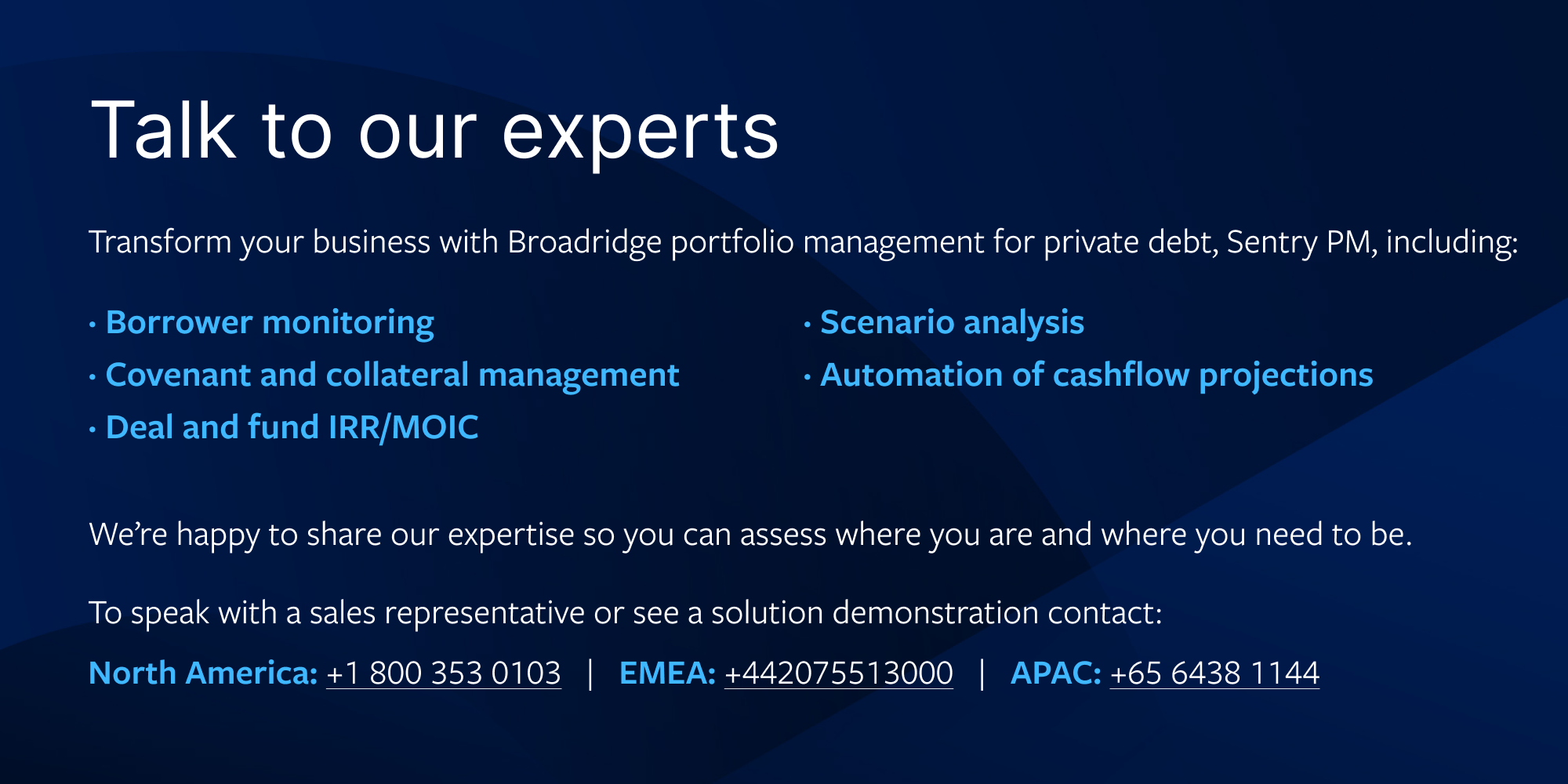Additional Broadridge resources:
View our Contact Us page for additional information.
One of our sales representatives will email you about your submission.
Welcome back, {firstName lastName}.
Not {firstName}? Clear the form.
Want to speak with a sales representative?
Your sales rep submission has been received. One of our sales representatives will contact you soon.
Our representatives and specialists are ready with the solutions you need to advance your business.
Want to speak with a sales representative?
| Table Heading | |
|---|---|
| +1 800 353 0103 | North America |
| +442075513000 | EMEA |
| +65 6438 1144 | APAC |
Your sales rep submission has been received. One of our sales representatives will contact you soon.
Want to speak with a sales representative?
| Table Heading | |
|---|---|
| +1 800 353 0103 | North America |
| +442075513000 | EMEA |
| +65 6438 1144 | APAC |
Nos représentants et nos spécialistes sont prêts à vous apporter les solutions dont vous avez besoin pour faire progresser votre entreprise.
Vous voulez parler à un représentant commercial?
| Table Heading | |
|---|---|
| +1 800 353 0103 | Amérique du Nord |
| +1 905 470 2000 | Canada Markham |
| +1 416 350 0999 | Canada Toronto |
Votre soumission a été reçue. Nous communiquerons avec vous sous peu.
Vous souhaitez parler à un commercial ?
| Table Heading | |
|---|---|
| +1 800 353 0103 | Amérique du Nord |
| +1 905 470 2000 | Canada Markham |
| +1 416 350 0999 | Canada Toronto |
Private debt is well-positioned to navigate challenging market conditions
Sparked by inflation, falling equity markets, interest rate movements, and increasing recessionary risk, asset managers have struggled to generate returns for clients, with the S&P Composite 1500 Asset Management Index down 22% last year.
Asset managers have experienced a combination of increasing costs and regulations, together with growing competition from passives — all of which are putting pressure on the industry.
Compounding matters further is that asset managers have suffered significant outflows during the last 12 months. According to Broadridge Global Market Intelligence (GMI) data, global assets under management (AUM) fell by 13% in 2022 to $96 trillion, making it the second largest single-year decrease since 2005.i
Unstable market conditions are prompting asset managers to expand into new strategies, like private debt, which are strategically positioned to endure these challenging market trends. Alongside the advantages of diversification, private debt also offers a means for managers to distinguish themselves from other industry players.
According to research conducted by Broadridge GMI, AUM overseen by private debt companies experienced a compounded yearly growth rate (CAGR) of 13.3% from 2015 to 2021, with the sector presently overseeing $1.1 trillion.ii
Preqin foresees that AUM expansion within this asset category will experience a CAGR of 10.8% from December 2021 to December 2027, culminating in AUM reaching $2.3 trillion.iii Unlike long-duration fixed-income instruments, private debt primarily comprises floating-rate loans, resulting in yields that trend upwards alongside rising interest rates.
In addition, more asset managers are launching Business Development Company (BDC) funds as they seek to diversify their investment portfolios and capitalize on the potential for higher yields in the private debt and lending market. The BDC structure allows firms to gain exposure to a variety of middle-market businesses, providing them with opportunities for enhanced returns and greater risk management flexibility.
Preqin reports that 36% of investors are drawn to private debt because of its reliable income streams, while 37% prioritize the asset class's strong risk-adjusted returns.
Asset managers increasingly see private debt strategies (plus other illiquid strategies, such as private equity) as a way to access a wider mix of institutional investors. Other managers see private debt as an opportunity to target a larger share of retail investors. Historically, retail investors have eschewed alternatives, but the poor yields that were previously being generated by traditional assets in the low-interest rate environment prompted many to reconsider this approach. Increasingly, retail investors are looking to capture returns by investing in private market strategies such as private debt. By launching illiquid strategies, long-only firms could grow their retail investor wallet share.
A diverse client base can help shield managers against withdrawals during bouts of volatility, especially in some of their more liquid funds.
Regulators are further promoting retail participation by creating fund options tailored to retail investors. The U.K.'s Long Term Asset Fund (LTAF) and the EU's European Long Term Investment Fund (ELTIF) serve as illustrations of this trend. Recognizing the fundraising potential within the illiquid sphere, several prominent asset managers, like Aviva Investors, have introduced LTAFs.iv
So what makes private debt so attractive to asset managers?
Amid the slow growth, high interest rate, and high inflation environment, private debt is well positioned. With banks tightening up lending to Small and Medium Enterprises (SMEs), many of these organizations are turning to private debt funds for loans. As borrowing costs rise, there has also been a shift from public debt to private debt.
Following the global financial crisis and subsequent Eurozone sovereign debt crisis, banks worldwide have sought to unload problematic loans from their balance sheets, with private debt firms displaying eagerness as buyers.
The ongoing economic uncertainty is having a mixed impact on private debt. Although volatility stresses existing borrowers and weakens portfolio performance, it also creates opportunities for managers to craft customized deals. It is crucial for managers to prioritize sound governance and implement robust covenants, however.
As more asset managers embrace private capital-style structures and investment approaches, firms need to ensure that their internal operations can effectively adapt to these changes. Unlike traditional trading strategies, handling private debt instruments requires specialized expertise, particularly in credit analysis.
This shift also necessitates fund managers to invest in technology systems capable of managing intricate and highly customized asset classes. Enhanced automation and a move away from manual processes are crucial for effectively overseeing and managing the risks associated with private debt in portfolios. Technology enables managers to closely monitor portfolio companies, cater to unique market demands, and capitalize on associated yields.
Certain managers might choose to delegate middle and back-office tasks to reputable third-party entities with a strong history of supporting various asset classes and financial instruments through automated custom workflows.
Broadridge's Portfolio Management solution for private debt effectively streamlines various activities including research, origination, administration, and reporting. This integration empowers managers to simplify their middle and back offices using a single, comprehensive system. Additionally, the system facilitates the management of deal pipelines and borrower financials, which holds particular significance amid the current market uncertainties.
It is evident from an investor’s perspective that managers must attain scalability and enhanced reporting processes through digitalization. Meeting the needs of institutional investors significantly differs from those of retail investors.
There are positive indications of adaptation within the private capital industry. According to Broadridge's 2023 Digital Transformation study, 61% of private capital managers consider digital transformation their most crucial strategic endeavor.
As asset managers transition to new asset classes and target diverse investors, substantial modifications to their operational and technological frameworks will be imperative.
i Broadridge – October 20, 2023 – Global Market Intelligence
ii Broadridge – October 20, 2023 – Global Market Intelligence
iii Preqin – December 14, 2022 – Brisk fundraising for private debt in 2022 – Preqin Global Reports 2023
iv Aviva Investors – May 2, 2023 – Aviva Investors launches Long Term Asset Fund

Designed for Private Debt, adaptable to any workflow
View ProductContact Us about what’s next for you
Contact UsOur representatives and specialists are ready with the solutions you need to advance your business.
Want to speak with a sales representative?
| Table Heading | |
|---|---|
| +1 800 353 0103 | North America |
| +442075513000 | EMEA |
| +65 6438 1144 | APAC |
Your sales rep submission has been received. One of our sales representatives will contact you soon.
Want to speak with a sales representative?
| Table Heading | |
|---|---|
| +1 800 353 0103 | North America |
| +442075513000 | EMEA |
| +65 6438 1144 | APAC |


